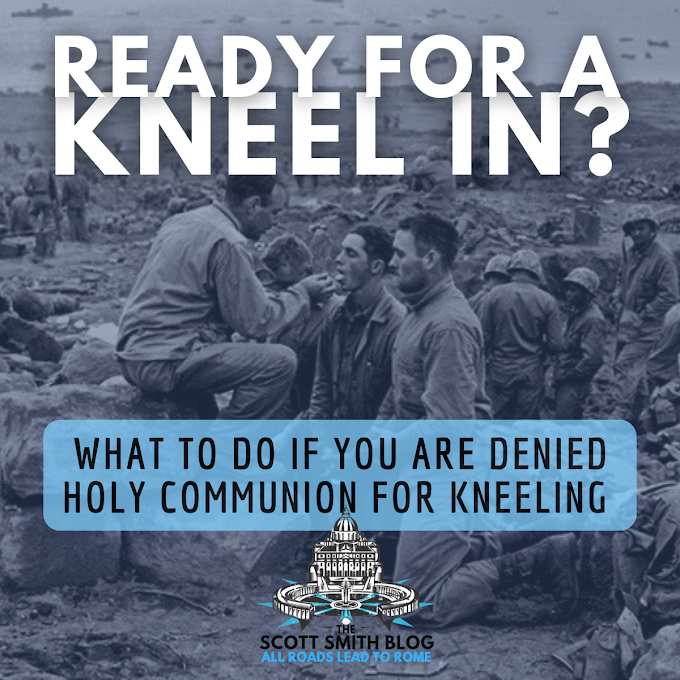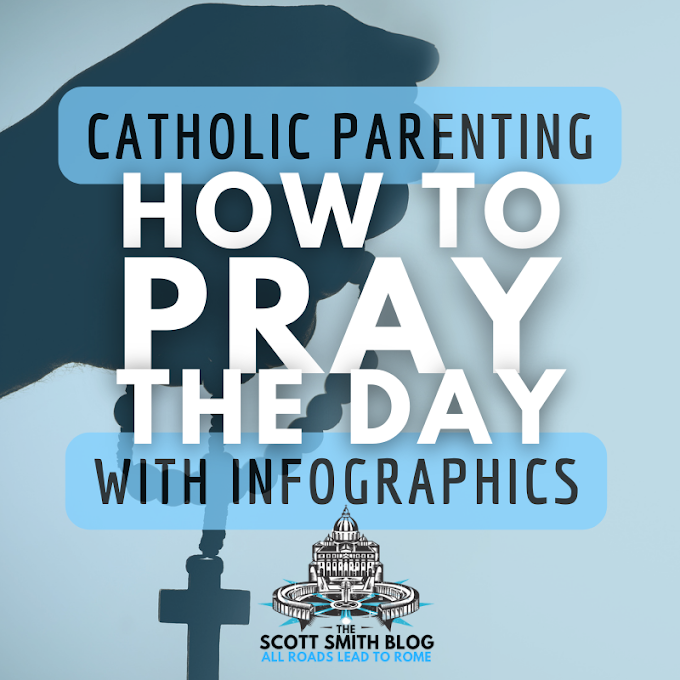Protestants will often tell us that Jesus is dismissive of his Blessed Mother. They even argue that Jesus rebuked the Virgin Mary at the Wedding at Cana when He said, "Woman, what have you to do with me?"
Ouch. That sounds harsh. But is it? What is Jesus really saying here? Is Jesus being disrespectful when He calls His mom, "woman"? And what about "what have you to do with me?" Surely, the combination is disrespectful. Right?
Nope.
I will demonstrate to you that these phrases convey enormous respect, even Queenly respect to the Blessed Mother.
Enjoy learning about the Blessed Mother and especially how to defend her? I've put together an entire e-course and book on the Virgin Mary in Scripture:
Why Does Jesus Address Mary as "Woman"?
First off, "Woman". Why does Jesus call his mother "woman" instead of "mother"? I want to focus on the second half of this -- "what have you to do with me?" -- so I will cut to the chase. By calling her "woman," Jesus is referring to His Mother as the New Eve.
I have already written about this extensively. Check out these articles for more on the New Eve: "What's Really Going on at the Wedding at Cana?" and "What is the Protoevangelium?"
Where else is this phrase "What have you to do with me?" found in the Gospels?
The phrase "What have you to do with me?"[1][2] is found in five places in the Gospels, including the Wedding at Cana at John 2.
Just peruse the other four instances of "What have you to do with me?" What do they all have in common? Note that some of these are repeated across the synoptic Gospels
Jesus Heals the Gadarene Demoniacs [Matthew 8:28-32]
28 And when he came to the other side, to the country of the Gadarenes, two demoniacs met him, coming out of the tombs, so fierce that no one could pass that way. 29 And behold, they cried out, “What have you to do with us, O Son of God? Have you come here to torment us before the time?” 30 Now a herd of many swine was feeding at some distance from them. 31 And the demons begged him, “If you cast us out, send us away into the herd of swine.” 32 And he said to them, “Go.” So they came out and went into the swine; and behold, the whole herd rushed down the steep bank into the sea, and perished in the waters.
Jesus Heals the Gerasene Demoniac [Mark 5:1-7]
1 They came to the other side of the sea, to the country of the Ger′asenes. 2 And when he had come out of the boat, there met him out of the tombs a man with an unclean spirit, 3 who lived among the tombs; and no one could bind him any more, even with a chain; 4 for he had often been bound with fetters and chains, but the chains he wrenched apart, and the fetters he broke in pieces; and no one had the strength to subdue him. 5 Night and day among the tombs and on the mountains he was always crying out, and bruising himself with stones. 6 And when he saw Jesus from afar, he ran and worshiped him; 7 and crying out with a loud voice, he said, “What have you to do with me, Jesus, Son of the Most High God? I adjure you by God, do not torment me.”
The Man with an Unclean Spirit [Mark 1:23-24]
23 And immediately there was in their synagogue a man with an unclean spirit; 24 and he cried out, “What have you to do with us, Jesus of Nazareth? Have you come to destroy us? I know who you are—the Holy One of God.”
The Man with an Unclean Spirit [Luke 4:33-34]
33 And in the synagogue there was a man who had the spirit of an unclean demon; and he cried out with a loud voice, 34 “Ah! What have you to do with us, Jesus of Nazareth? Have you come to destroy us? I know who you are—the Holy One of God.”
So, what do all 4 of these have in common? They all involve demons submitting to the will of God. So, wait ... why is Jesus using the same phrase as the demons?
All Other Uses of "What have you to do with me?" Involve Demons Throwing Themselves at the Feet of Jesus in Submission to God's Will
I especially like St. Mark's description of the Gerasene demoniac. Mark describes the local people as being completely unable to bind, fetter, and control this possessed man:
Mark 5:3-4: ... no one could bind him any more, even with a chain; for he had often been bound with fetters and chains, but the chains he wrenched apart, and the fetters he broke in pieces; and no one had the strength to subdue him.
Wow. This guy is wrenching apart chains. That's superhuman strength brought on by demonic possession. Yikes.
So, this possessed man that cannot be held by chains, ropes, manacles, whatever - what does he do? As soon as Jesus steps ashore, this man sees "Jesus from afar" and "ran and worshiped him." This man that cannot be contained by iron and chains throws himself down before Christ in obedience. This man, who would not submit to force of any kind, throws himself down before Jesus in supplication.
The demons have no choice but to bow down and (unwillingly) worship Jesus. Jesus' power over the demons is absolute. The demons have no choice but to submit to Jesus' will.
And Jesus uses the same words to answer His Mother.
Jesus' Obedience to His Mother, the Queen Mother
What can this mean? It means that Jesus was being obedient to his mother. Jesus was following the Fourth Commandment, "Honor thy father and mother."
It means that Jesus was submitting His will to His mother's will.
It also means that Jesus was honoring Mary's role as the mother of the king, the Queen Mother of Israel. Read more on the Queen Mother of Israel here and how the Wedding at Cana connects to 1 Kings 2:
Look again at those four times "What have you to do with me?" is used in Scripture. Jesus' name is used each time, as well. Each time, the demon addresses Jesus by name:
- Matthew 8:29, "What have you to do with us, O Son of God?"
- Mark 5:7, "What have you to do with me, Jesus, Son of the Most High God?"
- Mark 1:24, "What have you to do with us, Jesus of Nazareth?"
- Luke 4:34, "What have you to do with us, Jesus of Nazareth?"
Only it's not just Jesus' name being used. Half the time, it's Jesus title that used: "Son of God" and "Son of the Most High God."
So, how does Jesus address the Virgin Mary when Jesus says "What have you to do with me?" at John 2? Jesus says, "Woman, what have you to do with me?"
Is Jesus using "Woman" as Mary's title? When Else Does Mary bear a title in the Gospels?
But this isn't the only time the Virgin Mary is addressed with a royal title in Scripture ...
When else is the Virgin Mary addressed with a Royal Title?
Think about how the angel Gabriel addresses Mary: "Hail, Full of Grace!" The Angel doesn't say "Hail, Mary, full of grace." Gabriel says "Hail, Full of Grace!"
Think about all the other times that "Hail!" is used in the Gospels. It's just a few more times.
Can you think of them? Almost every one follows the same formula: Hail + royal title.
"Hail, King of the Jews!"
Here's an article breaking down these "Hail" verses in detail:
So, Does that Flip the Script? From Disrespect to Complete Obedience
Footnotes on "What Have You To Do With Me?"
[1] In the Greek, Jesus says ti emoi kai soi, gynai, “What for me and you, Woman?”, with “Woman” directly following “you.” The New Testament offers even clearer illustrations of the rhetorical purpose of ti emoi kai soi. The demon who asks “ti emoi kai soi, Jesus, Son of the Most High God?” (Mark 5:7) Literal translation: “What does this matter to me and to You?”
[2] Alternate John 2:4 Translations:
BIBlId [1699-3225 (2008) 12, 103-133]
Ti/emoi\kai\soi/, gu/nai; (John 2:4) Philological, contextual, and exegetical arguments for the understanding: “What does this matter to me and to You?”
The English translations, apart from the New Revised Standard Version (NRSV), to which we shall return, all render this question in a more or less similar way. The Revised Standard Version (RSV) runs as follows: “O woman, what have you to do with me? My hour has not yet come”; likewise, the American Standard Version (ASV) has: “Woman, what have I to do with thee? mine hour is not yet come”. Other old versions are very similar, such as the King James Version (KJV): “Woman, what have I to do with thee? mine hour is not yet come”, the Darby Bible: “What have I to do with thee, woman? mine hour has not yet come”, and the Webster translation: “Woman, what have I to do with thee? my hour is not yet come”. Luther’s version, too, is entirely analogous: “Weib, was habe ich mit dir zu schaffen? Meine Stunde ist noch nicht gekommen”, just like the Italian CEI translation, “Che ho da fare con te, o donna? Non è ancora giunta la mia ora”, and the French Bible de Jérusalem version: “Que me veux-tu, femme?”. With a slight improvement, but also with a very free rendering, the God’s Word Version has: “Why did you come to me? My time has
[3] Also, notice that Jesus begins with this title. He says "Woman" before "what have you to do with me?" The demons do the opposite. The demons put the title at the end of their statement. Jesus is being respectful of his mother, while the demons are being disrespectful.
Of course, this is only in the English. In the Greek gynai still comes at the end: ti emoi kai soi, gynai.





















4 Comments
I thought you might be interested in an apparent Hebrew version of the phrase you've discussed here. Look at 1 Kings 17, and the episode starting at v17, where Elijah calls upon God to restore life to the widow's son (a precedent for Our Lord and Lazarus). At v18, she says to Elijah, whom she entitles "Man of God":
מה לי ולך
which is literally "What to-me and-to-you [?]" ("to" could also be rendered "for" in some contexts)
I'm not a professional scholar, but I've read various discussions of the phrase in Greek without seeing any comparison with the Hebrew phrase, which is surely the origin of the Greek (and I would guess that it was not an idiom in the Greek of the times, but just a word-for-word translation from Hebrew or Aramaic).